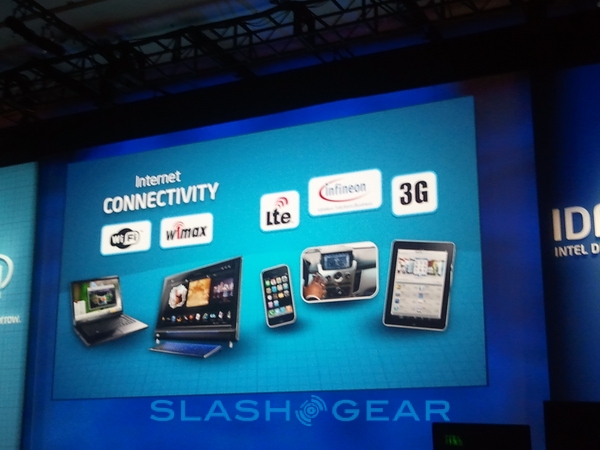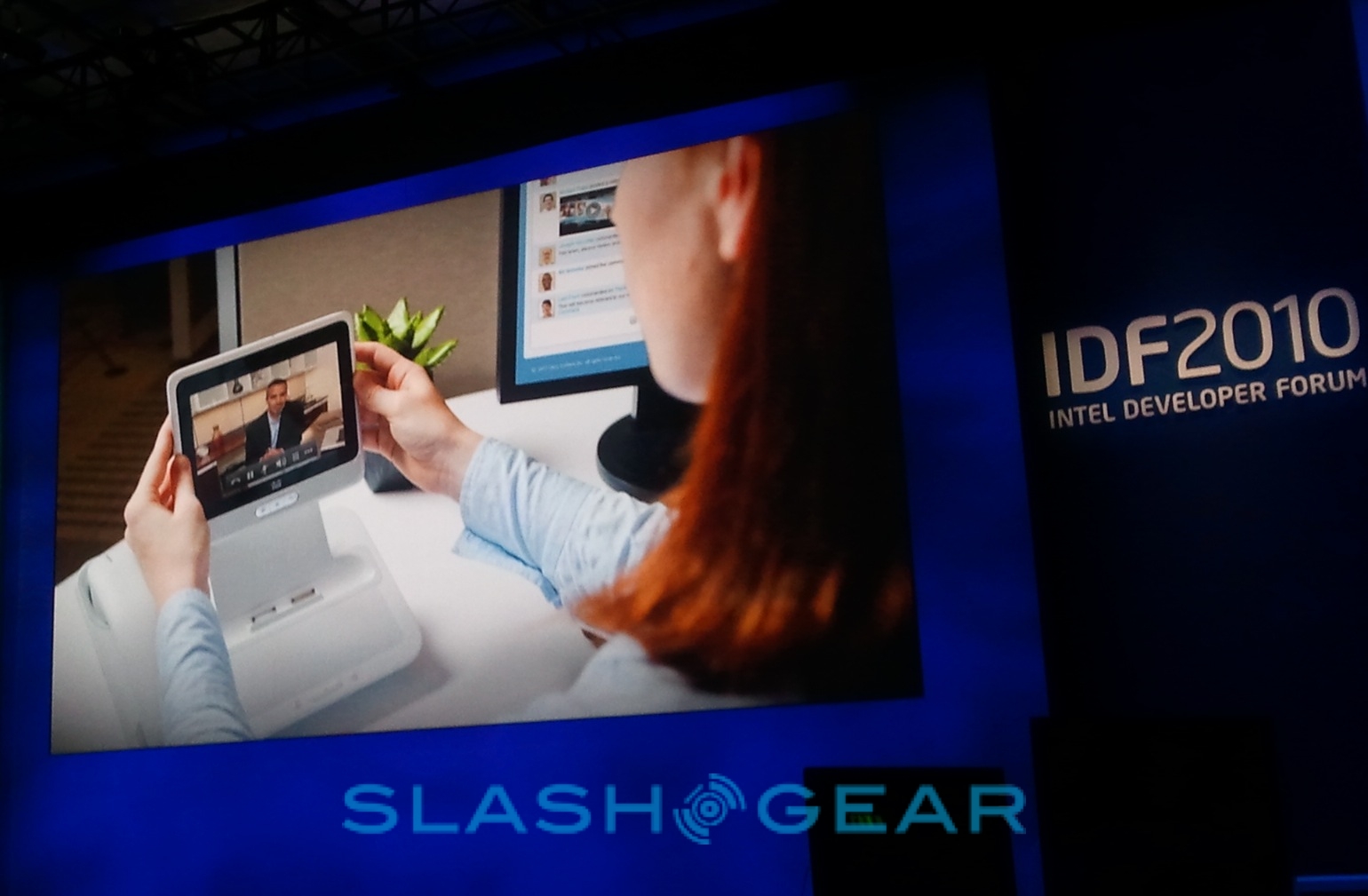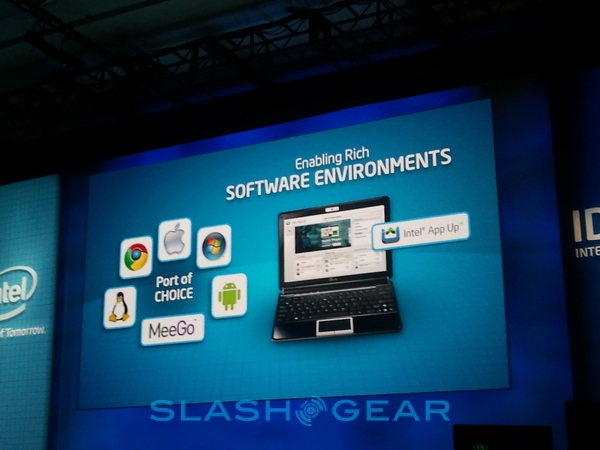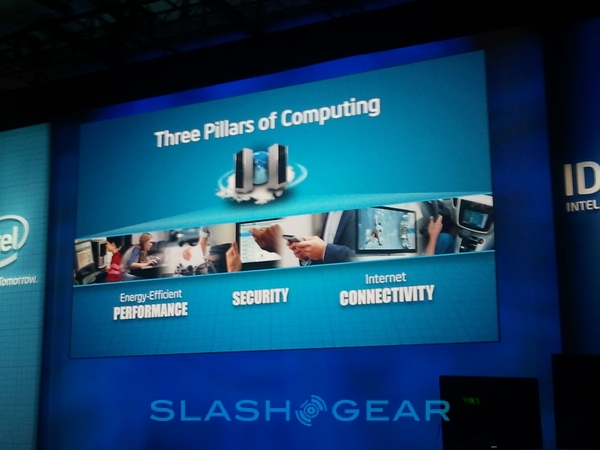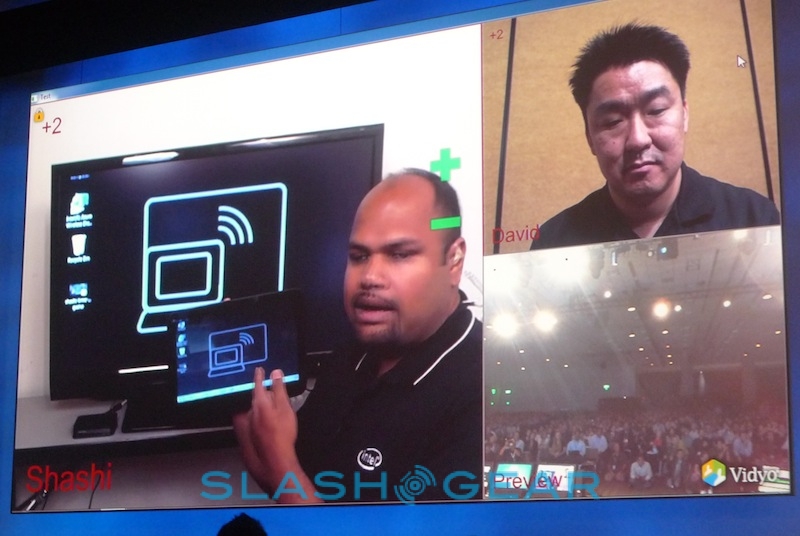Intel Push Smart TV, WiDi Tablet And Name-Check iPad At IDF 2010 [Update: Video!]
It's not just new CPUs at IDF 2010; Intel is also making a big deal out of Smart TV products and the spread of internet connectivity, highlighting its involvement in next-gen set top boxes such as Logitech's Revue for Google TV and the recent platform-switcher, D-Link's Boxee Box. Intel's Atom CPU is unsurprisingly at the core of their drive, with chips like the CE4100 taking center stage.Update: Video demo of the Intel WiDi tablet, motion-recognition system and more after the cut
The company's WiDi or Wireless Display tech also got a name-check and an on-stage demonstration, with Intel showing a handheld tablet being used with WiDi to beam content onto a big-screen HDTV. Having acquired Infineon's wireless division, they also got a chance to namecheck the iPad among their "internet connectivity" push, while supported software environments included Linux, Google Chrome OS, Android, OS X, Windows and MeeGo.
Intel IDF 2010 demonstrations:
[vms feedfdeaab192ead4ac0]
Finally, various demonstrations to show the potential of the 2011 Core CPUs were made, including simultaneously playing Starcraft II: Wings of Liberty on a laptop while recording an HD video, together with 3D gesture tracking with GestureTek software. The new Core chips' support for AVX will allow for more compute-heavy motion and facial recognition tracking, image, video and audio processing, and computational simulation and analysis.
Press Release:
Intel Innovating to Deliver Seamless Experiences Across Smart, Connected DevicesNEWS HIGHLIGHTS
Otellini described how the spread of smarter, Internet-connected devices presents engineering challenges and opportunities for the industry.
Intel is extending its chip design, manufacturing techniques and software expertise to offer more complete hardware and software platforms and related services for new market segments.
Innovative technologies and concepts demonstrate Intel's leading computing architecture delivering a consistent, interoperable Internet experience across a range of devices.
Smart TV-enabling products to become available this Fall from D-Link*, Google*, Logitech*, Sony* and Telecom Italia*.
SAN FRANCISCO, Sept. 13, 2010 – Intel Corporation's CEO Paul Otellini today highlighted several trends and technologies that have created a "new marketplace for pervasive computing" that poses engineering challenges that are also opportunities for the high-tech industry.
These trends include the proliferation of billions of smarter, Internet-connected devices that include PCs, phones and cars; and how individuals want to seamlessly move between devices to connect with friends, get information and be entertained. Otellini said people "will choose the device that provides the best experience for any given intended use and that no one device will win."
Intel is positioning itself to advance – and benefit from – this transformation in the computing marketplace. The company is extending its chip design, manufacturing techniques and software expertise to offer more complete hardware and software platforms and related services that deliver energy-efficient performance, security and Internet connectivity across a large, dynamic range of devices. The company is developing products that span high performance PCs and servers to a broad range of other "smart" devices that currently or soon will connect to the Internet.
"Computing has become an indispensible part of our daily lives," Otellini said in a tone-setting speech to open the company's semi-annual Intel Developer Forum. "Our vision is to create a continuum of personal computing experiences that provides consistency and interoperability across all Internet-connected devices in the home, car, office or in your pocket.
"At the heart of this continuum will sit Intel technology that will make devices smarter, more powerful and more useful," he added. "We're changing how we develop and deliver solutions so we can deliver on this vision."
Intel has made limited investments beyond the PC in recent years. However, it has made nearly $10 billion in acquisitions over the last year – starting with Wind River – to help the company extend its capabilities. Otellini said Intel's recently announced, planned acquisitions of Infineon's* Wireless Solutions Business and McAfee Inc.* will enhance the company's ability to deliver products that offer a choice of wireless connections, and more effectively counter the increasingly sophisticated security attacks happening on a broad range of Internet-connected devices. The planned purchase of Texas Instruments'* cable modem business will add to Intel's ability to deliver Internet services to consumer electronics devices.
Intel's CEO also described how the benefits of Moore's Law and Intel's leading-edge transistor technology are being applied to different computing segments for increasingly capable and energy-efficient processors. The company's unique High-k metal gate transistor technology enables 10 times less power leakage from generation to generation while continuing to improve performance.
"There's tremendous innovation happening for PCs today," Otellini said, citing several examples including the upcoming 2nd Generation Intel® Core™ processor family, Intel® Wireless Display technology, and manageability technology for business PCs. "I'm excited about Intel's prospects for bringing its rich history of computing expertise to other markets."
The Intel® Core™ processor, Intel® Atom™ processor and Intel software tools are playing a role transforming data centers, the Internet "cloud" and other areas that are being transformed by the proliferation of smarter, Internet-connected devices. Otellini highlighted Intel's progress in these areas. He also demonstrated several technologies that showed Intel's leading computing architecture delivering a consistent and interoperable Internet experience across multiple devices.
"We're excited by how the TV industry is making a transition from having just a few Internet-based services to a truly integrated Internet experience," Otellini said. "We call this new category smart TV, and products are beginning to take off around the world."
Otellini showed two smart TV-enabling products powered by the Intel® Atom™ processor CE4100 and Google* TV that will come out this Fall. The Sony Internet TV and the Logitech Revue* add-in box seamlessly combine access to the Internet with the TV viewing experience through the combination of Intel processors and the Google TV Android* platform. D-Link*, Telecom Italia* and several other companies are also expected to launch Intel® Atom™ processor CE4100-based devices soon.
Intel's success in the embedded processor area is continuing with design wins for Intel Core and Intel Atom processors in more than 30 market segments that include cars, home energy management and digital signage. There currently are more than 3,800 embedded customer engagements for the Intel® Atom™ processor.

